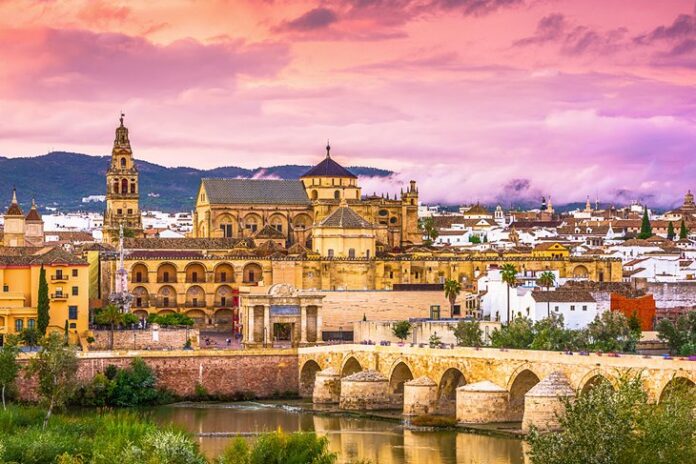Euro international : Few tourism destinations in the world offer such a dazzling array of places to see and tourist attractions to visit as Spain. This European country is also filled with striking natural scenery and beauty, from the rugged Sierra Nevada mountain range to the white sand and blue lagoons of its Mediterranean islands like Ibiza.
The country is also fascinating due to the different cultures of its distinct regions. There is just so much history here, much of which can be explored in any single city. Many Spanish cities have ancient Roman ruins and Islamic architecture from the Moorish period, medieval castles and fortifications along with Castilian- and Hapsburg-era palaces and mansions. Most also feature many examples of modern Art Nouveau, Art Deco, and Modernist architecture.
The country also represents the pinnacle in all things related to the sheer enjoyment of life: delicious food; great art; amazing music; lively dances; and warm, friendly people. Plan your Spanish adventures with our list of the best places to visit in Spain.
1. Madrid

Spain’s large capital city showcases the country’s incredible history. It’s a perfect holiday destination, as there are royal palaces, marching soldiers, changing of the guards, and hundreds of museums to visit.
No visit to Madrid is complete without visiting all three of the city’s major museums. The Prado Museum (officially called the Museo Nacional del Prado) showcases what was formerly the Spanish royal collection of art, while the nearby Reina Sofia Museum shows modern masterpieces like Picasso’s moving Guernica. Also, the nearby Thyssen-Bornemisza Museum combines Old Masters with the best in contemporary art.
Madrid is also a classic, European strolling city, filled with green spaces to enjoy like the Buen Retiro Park, as well as wide, pedestrian-only boulevards like the iconic Gran Via. The food culture also thrives here, from casual tapas tasting cuisine to cutting-edge, Michelin-starred molecular gastronomy.
La Latina, one of the city’s oldest neighborhoods, has evolved into tapas-central with a plethora of tapas-serving establishments, most with outdoor terraces. It’s fun to go from place to place sampling each one’s specialties.
2. Barcelona

The second largest city in Spain offers a completely different travel experience compared to Madrid. Its coastal location gives it more of a resort feel, complete with warm, sunny weather to enjoy on most days of the year. It’s on the country’s northeast coast, by the Mediterranean Sea, and also seems to have a much more modern, progressive vibe than Madrid and other Spanish cities.
Must-see tourist attractions in Barcelona include the city’s immense (and perpetually unfinished) Sagrada Familia modern cathedral and the Joan Miro museum, conceived by the iconic artist himself before his death. Other good places to see in Barcelona include the city’s almost three miles of beaches and La Rambla, a huge, tree-lined, pedestrian-only street. It’s where the entire city seems to come out for a stroll.
Continue to where La Rambla meets the water, and you’ll find the Maremagnum shopping mall. It’s on its own man-made island, almost completely surrounded by water. You get to it by walking over a very cool wooden drawbridge, called Rambla de Mar. It opens each hour to let sailboats and yachts pass through. Head to La Terraza, the mall’s panoramic platform with 360-degree views of the water and city skyline. The city’s large aquarium is next to the mall on the same little peninsula and is well worth a visit.
Be sure to take the funicular (incline railway) up to the summit of Tibidabo, a local mountain with a beautiful church and amusement park at the top. You’ll also be rewarded with spectacular views of the city and surrounding countryside.
3. San Sebastian

This resort city is on the north coast of Spain, in the Basque region. San Sebastian is right on the scenic Bay of Biscay, which opens to the Atlantic Ocean. It’s a popular surf town, with quite a surfing scene at Playa de Zurriola. A visit also provides the opportunity to experience the unique Basque culture.
Things to do here include spending some time on the sandy beach of La Concha or maybe hiking up Monte Orgull, the fortress-topped mountain overlooking the city’s harborside old town area. It’s also fun to spend time in that cobblestoned old town, called Parte Vieja. The neighborhood is filled with really nice, locally owned shops and lots of places to sit and enjoy pintxos (the Basque version of tapas).
4. Valencia

Valencia is a port city with a long connection to the sea and to Spain’s trade with the world, especially with Europe, the Middle East, and Africa. It’s on the Mediterranean Sea, on the country’s southeastern coast. As a coastal city, there are some nice beaches to enjoy. Another outdoor place to see is Albufera Park, a beachside wetlands reserve with a lot of hiking trails (and some good beaches).
The city has many museums. A highlight is the Museum of Fine Arts (Museu de Belle Arts de Valencia), with its excellent collection of Spanish masters by artists like El Greco and Goya. There’s also a large, Gothic-style cathedral in the medieval center of the old city along with remnants of the old city walls.
Be sure to visit the Torres de Serranos, one of the only standing gates to the walled city and a prison for over 300 years. The National Museum of Ceramics and Decorative Arts, “González Martí,” is filled with cool stuff. Spanish decorative arts is the focus here, with an incredible collection of ceramics, traditional costumes, and furniture. Kids will love the Natural Science Museum and its large collection of dinosaur skeletons.
When you get hungry, head to the city’s Mercado Central, a vast Art Nouveau-style market hall (built in 1914) filled with food vendors and cafés (along with souvenir shops and other tourist-type businesses). Although it’s a popular tourist attraction, you’ll be surrounded by locals, too, as it’s where they go to eat and hang out.
5. Granada

Home to the spectacular Alhambra Moorish hilltop palace and fortress, Granada is another vibrant destination in the southern region of Andalusia. It features more incredible examples of Islamic architecture, including the Alhambra castle complex. There’s an entire preserved Moorish old town area called The Albaicín, with narrow streets and most buildings dating from the 8th, 9th, and 10th centuries. It’s a great tourist destination, as you can experience ancient and modern Spain in the same place.
Granada also puts you close to Europe’s most southern ski resort area: Sierra Nevada. Only 42 kilometers (26 miles) outside Granada, the large resort has over 100 runs served by 17 lifts and two cable cars. The high elevation means the ski season can run from late November through early May. Sierra Nevada is only 164 kilometers (102 miles) from the sunny beaches of Málaga. This means you can ski in the morning and spend the afternoon at the beach (or vice-versa).
There’s a big university in Granada and a thriving modern cultural world, with delicious food, places to go for tapas, and flamenco music and dance. Royal Spain is represented here with an ornate, 16th-century cathedral, which houses the tombs of King Ferdinand and Queen Isabella, who united the country (and sponsored Christopher Columbus’ journeys of discovery).
6. Ibiza

One of the best vacation spots in Spain for couples is the resort island of Ibiza. It’s a short flight or a five- to six-hour ferry ride away, and is located about 100 miles off the Spanish coast. Ibiza is the largest of the Balearic Islands, a group of mainly resort islands in the Mediterranean Sea. The other three largest islands, Mallorca, Menorca, and Formentera are also popular places to see in Spain.
Ibiza may be best known for electronic music, beach parties, and massive dance clubs, but it’s also filled with a lot of great family resorts and lots of fun things to see and do with kids. It has something for everyone and is a good destination for singles, couples, and families. Resort areas on Ibiza include Portinatx in the north, San Antonio in the west, and Santa Eulalia in the east.
7. Córdoba

This ancient city in the Andalusian region in the south of Spain allows you to explore Spain’s history going back several thousand years to the time when it was a part of the Roman Empire. Córdoba was an important Roman city (called Corduba), and many ruins and preserved Roman sites remain, including a 16-arch bridge across the Guadalquivir River.
Córdoba was a major Islamic center during the Middle Ages, and has some incredible architecture from that time period, the highlight being the city’s large mosque. Called La Mezquita, the mosque was built in the 8th century and later converted into a Christian church in the 13th century. There is also a long Jewish history in the city (and all over Spain), and a 14th-century synagogue can be visited in the medieval Judería or Jewish quarter.
Cordoba has many museums. The Museo Arqueológico de Córdoba presents the city’s (and Spain’s) history going back thousands of years. An added attraction, the museum is on the site of Cordoba’s ancient Roman theater. The theater has been excavated and can be visited in the museum’s basement level.
8.Seville

A beautiful and fascinating city in southern Spain, Seville is another example of the country’s living history. It’s a compact city, great for sightseeing, filled with Roman ruins, Moorish structures and palaces, and Gothic churches from Castilian rule (the period when Spain was ruled by kings and queens).
Islamic history and culture is especially rich here, as the city was the capital of the ruling Moorish dynasty for most of the time it was under their control. It also blossomed during Spain’s Golden Age, from the 15th to 18th centuries, when it was the only port allowed to officially receive trade from Spanish colonies in the Americas.
Music and dance is also taken very seriously here, as Seville is the home of flamenco dancing and the related musical style. Flamenco can be enjoyed in Tirana, a neighborhood filled with small cafés and performance venues. Santa Cruz is another popular area to explore; it’s home to the city’s huge Gothic cathedral and the royal palace complex, called the Real Alcazar. The palace, originally built for the city’s Islamic rulers, is real living history, as the current Spanish royal family uses it when they’re in town.
9. Bilbao

This northern Spanish city is the capital of the Basque region, which can feel like a different country. It’s part of Spain but officially considered an “autonomous community.” The language (also called Basque) here is different from other parts of Spain, as are the food, music, and overall culture. The 1997 opening of the incredible curvy, titanium-clad, Frank Gehry-designed Guggenheim Museum really put this former gritty industrial port city on the world tourism map as a must-visit place to see in Spain.
In addition to the art inside the museum, it’s surrounded by what’s known as the Art District. Here, you can find oversized pieces of art and sculpture too large to be viewed inside a building. It’s great for Instagram pics.
Cultural and tourism highlights include the incredible Guggenheim Museum Bilbao, the Plaza Berria (a big public square with lots of cool shopping and dining), and taking a stroll across the Zubizuri pedestrian bridge.
10. Málaga

Another great example of the vast cultural differences between Spanish cities, Málaga highlights the country’s North African influence. It’s on the Spanish Costa del Sol (only a short ferry ride from Africa), which is filled with a lot of generic, over-developed resort areas. Málaga is a large resort city but retains its Spanish (and African) roots as a port city.
Picasso was born here, and the city is home to a large museum featuring an impressive collection of his work. Like many other southern Spanish cities, there is a Moorish/Islamic influence here in the architecture and art. Two Moorish hilltop fortresses remain, the Alcazaba and the Gibralfaro. There’s also a large Renaissance-style cathedral.
The history and culture is balanced with a forest of modern, generic residential and rental apartment buildings, all fighting for ocean views. The region’s warm and sunny weather makes it a popular second home destination for residents of the UK and other colder European countries. Málaga’s beachfront and harbor areas are fun places to visit and offer some of the area’s typically wonderful food, especially seafood.
11. Costa Brava

Another great vacation spot in Spain is the stunning Costa Brava area of Catalonia. This is on the northern Mediterranean coast of the country, north of Barcelona, extending to the border with France. It’s filled with small beaches; rugged cliffs; and lots of small coves, bays, and inlets. Popular seaside resort towns on the Costa Brava include Blanes, Tossa de Mar, and Lloret de Mar. Take a day to explore (and snorkel around) the uninhabited Medes Islands, a short boat ride away.
Another cool place for sightseeing is a ruined, hilltop monastery, the Monasterio de Sant Pere de Rodes. Although it’s a ruin, most of the structures of the buildings, including the massive church, are intact. The monastery is in the Cap de Creus natural park area, quite near the town of Figueres, birthplace of Salvador Dali. The town is home to the large Dali Museum, which the artist himself had a hand in designing and planning.
12. Segovia

The Spanish city of Segovia is in central Spain, northwest of Madrid. The area is rich with Roman ruins and was also a key city in the post-medieval period of royal rule. There’s a Gothic cathedral (with a fascinating museum of religious art) located on the city’s Plaza Mayor main square. The Plaza Mayor area is a haven for foodies, as it’s filled with restaurants, cafés, and places to get tapas.
Sightseeing highlights in Segovia include the Moorish Alcazar fortress and castle, which was believed to be an inspiration for Walt Disney when creating Cinderella’s Castle for his theme parks. Other must-see attractions include the incredible, double-decked ancient Roman aqueduct and the city’s massive 16th-century Gothic cathedral.
13. Tarragona

With the ruins of a Roman amphitheater and a Roman circus chariot race track, Tarragona is one of the best places to see remnants of the ancient Roman world in Spain. It’s a port city in the Catalonia region, located in the northeastern part of the country. Known as “Tarraco” in ancient Roman times, the city has a 2nd-century arena, a necropolis of Roman tombs, and it even retains traces of the ancient forum. All this Roman history exists inside and around the medieval walled Old Town area.
There’s a long stretch of a two-story Roman aqueduct, which can be explored. Tarragona’s National Archeological Museum presents an excellent overview of the city’s history and showcases a vast collection of fascinating Roman (and older) artifacts.
When you’ve finished exploring the Roman history, head to Tarragona’s beautiful beachfront resort area and enjoy the clear, aqua blue water of the Balearic Sea.
14. Linares

A pilgrimage site for guitarists and flamenco guitar music lovers, Linares is the birthplace of Maestro Andres Segovia. The master guitarist elevated the instrument to the highest levels of musicianship. His performances around the world helped make the guitar a serious instrument now included with symphonic and orchestra music.
The Andres Segovia Foundation – Museum, housed in a restored 17th-century palace, showcases the life of Segovia, allowing visitors a chance to see his music, instruments, and other personal effects. The museum also contains a crypt with the tomb of the Maestro.
Linares is a city in the Andalusia region, about a 90-minute drive from either Cordoba or Granada.
15. Tenerife

The largest of Spain’s Canary Islands, Tenerife offers the full resort experience. It also offers some of Spain’s best golf. The islands are in the Atlantic Ocean, off the coast of Morocco, but their popularity as a resort destination means there are frequent flights from Spain and other European cities.
The Abama Golf resort gives players the chance to play a round on the side of a volcano. Playing the course feels like exploring a botanical garden with over 300 species of subtropical plants, combined with more than 20,000 palm trees and 22 lakes. The main draw here (aside from the challenging course) are the views. The entire course is elevated, and almost every hole has postcard views of the Atlantic Ocean and the neighboring island of La Gomera. Aside from golf, the resort has luxurious accommodation, multiple fine dining options, and a world-class spa.
SWITZERLAND PARADISE ON EARTH :TOP 9 PLACES TO VISIT IN SWITZERLAND
Ready to explore majestic Switzerland? Whether you’re visiting or relocating, don’t miss our top 10 places to visit in Switzerland.
Switzerland may be small but it has a whole host of great places to visit. From breathtaking mountain peaks to dreamy turquoise lakes and a countryside littered with ancient wonders, Switzerland really does have something for everyone.
In fact, there’s so much packed into Switzerland’s borders that expats and visitors alike will find it difficult to decide where to visit next. But fear not! With our guide to the top 10 places to visit in Switzerland, you’ll soon be exploring the stunning beauty of this unforgettable Alpine gem.
1. THE MATTERHORN
This pyramid-shaped giant is one of the world’s most photographed mountains, which means it’s definitely a top place to visit in Switzerland. Standing at an impressive 4,478 meters, thrill-seeking mountaineers from around the globe descend on Switzerland to attempt the summit. If you’re not feeling quite so energetic, why not stick to the cable car? The mountain is home to the highest cable car station in the Alps, which offers some excellent views of the mountain peak and beyond. It really doesn’t get much more Swiss than a trip to the Matterhorn.

YOU WON’T WANT TO MISS…
- Visting the Matterhorn Museum in Zermatt
- Instagramming from the Gornergrat observation platform
- Skiing on the Theodul Glacier 365 days a year
2. CHÂTEAU DE CHILLON
No trip to the Swiss Riviera is complete without checking out the medieval Château de Chillon. Located on an island in Lake Geneva near the popular town of Montreux, the castle dates back to the 10th century, when it was used as a strategic water fort. It then became a lakeside summer home for the wealthy Counts of Savoy, when the castle rooms were decked out with all manner of art and treasures visitors can enjoy today. The castle is Switzerland’s most-visited historical monument and is definitely a must-see while you’re exploring the country.

YOU WON’T WANT TO MISS…
- Taking in the castle’s three sumptuous great halls
- Gasping at the impressive weapons room
- Enjoying the boat ride from Montreux to the château
3. JUNGFRAUJOCH
The Jungfraujoch is an Alpine wonderland that fully deserves its nickname of the Top of Europe. Technically a glacier saddle between two mountains, the Jungfraujoch is one the best – and highest – attractions in Switzerland. And don’t let the altitude put you off – there’s plenty for the whole family up there, from mountain climbing to tobogganing and much more. However, perhaps the most impressive attraction is the world-famous Jungfrau railway. Starting at Kleine Scheidegg, the train climbs up to 3,454 meters above sea level to Jungfraujoch, the highest railway station in Europe.

YOU WON’T WANT TO MISS…
- Exploring the Ice Palace inside the glacier and seeing the famous ice sculptures
- Flying through the air on the popular zip-line
- Being amazed by the views from the Sphinx Observatory
4. SCHWEIZERISCHER NATIONALPARK
In a country with amazing scenery at every turn, it can be hard to know where to go. But one thing for certain is that you’ll want to visit the Swiss National Par near Zernez. As the country’s only national park, it’ll give you an idea of how the Alps were before tourism. From snow-crusted glaciers to captivating meadows, this place has it all. There are plenty of hiking trails to choose from, each taking visitors past unforgettable sights. And, if you’re lucky you might catch sight of some of the park’s local residents – red squirrels, ibexes, and red deer all call this park home.

YOU WON’T WANT TO MISS…
- Checking out the skies – golden eagles live in the area
- Learning about the bears that once roamed the park at the Schmelzra Museum
- Exploring one of the park’s 21 hiking routes
5. LAKE GENEVA
Stretching from Geneva in the west to Lausanne in the east, Lake Geneva is one of Switzerland’s most beautiful places. From the international bustle of Geneva to the many vineyards that crawl up the hillsides around the lake, there’s plenty to do in the surrounding region. And there’s a lot of activity on the lake, too. Windsurfing, water skiing, and kayaking are all possible for more active visitors to the area. Or, if you’re feeling a little lazier, you can simply sit back and take in the beauty of the lake from the deck of a paddle steamer as it crosses the water.

YOU WON’T WANT TO MISS…
- Tasting the local wines as you take a vineyard tour
- Taking the perfect Jet d’eau photo in Geneva
- Going night-skiing in the mountains when the temperatures drop
6. LUGANO
See Switzerland in a whole new light with a trip to the southern city of Lugano. Nestled on the shores of the breathtaking Lake Lugano, the city dubbed the Monte Carlo of Switzerland blends Swiss and Italian cultures into an unforgettable weekend break. Home to plenty of museums and warmed by Mediterranean breezes, you might even think you’re in nearby Italy when you visit. Outside the city, impressive villas are sprinkled around the lush hillsides that rise from the lake.

YOU WON’T WANT TO MISS…
- Seeing the best of Switzerland in miniature at the kid-friendly Swissminiatur
- Brushing up on your Italian by chatting to the locals
- Indulging your tastebuds with Lugano’s unique local delicacies
7. BERN
Not only is the medieval city of Bern Switzerland’s capital, but it’s also one of its most enchanting places to visit. Walk around the old town’s narrow cobblestone stones and you’ll soon realize just why the neighborhood is listed as a UNESCO World Heritage Site. All across Bern’s historic center, you’ll find a whole host of boutiques, bars, and bears. Yes, that’s right, a family of bears – the city’s symbol – lives at the city’s aptly named Bear Park just across the river from the old town. If that wasn’t enough, the city hosts plenty of lively markets, including some memorable Christmas markets during Advent.

YOU WON’T WANT TO MISS…
- Uncovering your inner genius at the Albert Einstein Museum, located in his old flat
- Telling the time at the famous Zytglogge, the landmark 13th-century tower
- Taking a dip in one of the city’s popular outside swimming pools
8. LUCERNE
In a country of picture-perfect lakeside cities, it doesn’t get much more impressive than Lucerne. Surrounded by three large mountains, the compact medieval city sits on the shores of Lake Lucerne. Wandering around the captivating old town, you’ll be forgiven for thinking you’ve stepped into a painting. There are ancient churches, bustling squares, and plenty of boutiques to explore as you marvel at the architectural wonder of the city. But the highlight is the Chapel Bridge, a covered wooden bridge that has been connecting the center of Lucerne since 1333.

YOU WON’T WANT TO MISS…
- Capturing the perfect shot of the majestic Chapel Bridge
- Getting a bird’s eye view from Lucerne’s city wall watchtowers
- Checking out Switzerland’s Transport Museum
9. RHINE FALLS
As Europe’s most powerful waterfall, it’s easy to see why Rhine Falls is one of the top things to do in Switzerland. Visitors can take in the beauty of the waterfall – located near the northern town of Schaffhausen – from several viewing decks. If you’re feeling more adventurous, you can even rent a canoe and check out some nearby castles from the water. Every August, the falls host a spectacular firework display that attracts visitors from around the country as part of Switzerland’s National Day celebrations.

























































